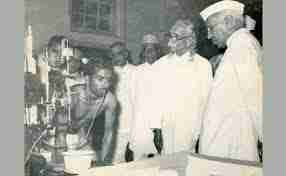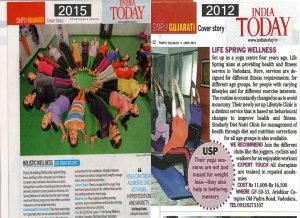
Swami Kuvalayananda’s emphasis on integrating scientific principles with the ancient wisdom of yoga resonates well with the current generation. By combining his extensive knowledge in the physical sciences, Indian philosophy, and yoga practices, he sought to provide a rational and practical understanding of yoga that could be embraced in the modern world. Hence Swamiji is known as a pioneer scientist of Yoga or the father of Scientific Yogic Research Studies.
According to some accounts, Gune (Swami Kuvalayananda) was initially exposed to postural yoga techniques at Jummadado Vyāyamśāla (gymnasium), baroda around the same time Sri Aurobindo sought guidance from yogis for his practice of hatha yoga. However, it wasn’t until 1919, under the tutelage of Parmahansa Madhavadasji Maharaja of Malsar, that Gune received formal and comprehensive training in yoga.
The primary focus of Kuvalayananda’s work revolved around the scientific study of yoga. He diligently searched for rational explanations for the physiological effects of asanas (postures) and pranayama (breathing exercises). Additionally, he devoted his efforts to developing yoga therapy as a means of treating various diseases.

However, during the early stages of his career as a nationalist reformer, Swami Kuvalayananda expressed three interconnected yet separate objectives:
- To equip the younger generation for serving the nation;
- To acquire mastery over the Indian System of Physical Education and harmoniously integrate it with general education;
- To unite science and spirituality by aligning the spiritual dimensions of Yoga with modern scientific principles.
Around 1920, Gune initiated his exploration into the physiology of yoga at the state hospital in Baroda. His research primarily focused on subjecting different aspects of yoga, such as asanas, pranayama techniques, and kriya actions, to rigorous laboratory testing. Through these experiments, Gune aimed to measure the impact of yoga on various physiological factors, including blood pressure, digestion, circulation, nerves, respiration, and more.
Kuvalayananda introduced three distinct and innovative concepts that were considered groundbreaking at the time.
- Firstly, based on his research, he formulated a comprehensive understanding of how individual asanas impact different physiological systems of the body.
- Secondly, he sought to determine the optimal duration for holding each static posture to maximize its physiological benefits. He also devised a progressive system to facilitate gradual advancement to higher levels of proficiency.
- Thirdly, recognizing the absence of a logical sequence for performing specific asanas and the lack of guidelines in existing literature, both contemporary and historical.
Kuvalayananda undertook the task of establishing a structured “course.” This course outlined a series of asanas, pranayama, mudras (seals), kriyas, and bandhas (locks) to be practiced in a rational order. In 1925, he published this course in the Kaivalyadham research journal, Yog Mimamsa.
Swami Kuvalayananda’s notable achievement was the establishment of the Kaivalyadhama Yoga Institute in Lonavala, India, in 1924. The primary objective behind founding Kaivalyadhama was to bridge the gap between the rich tradition of yoga and the scientific advancements of the time. Swami Kuvalayananda envisioned a harmonious union between the ancient wisdom of yoga and the rigors of scientific inquiry, aiming to make this profound knowledge both relevant and accessible to people worldwide. The institute became a renowned centre for the synthesis of traditional yogic practices and scientific research, ensuring that the benefits of yoga could be understood, studied, and applied in a practical and evidence-based manner.

“Yoga has a complete message for humanity.
It has a message for the human body,
it has a message for the human mind and,
it has a message for the human soul.”
– Swami Kuvalayananda, Founder, Kaivalyadhama
Driven by a strict rationalist approach, Swami Kuvalayananda dedicated his life’s work to seeking scientific explanations for the psychophysical effects he experienced through yoga. His quest was to uncover the scientific basis behind the transformative processes of yoga. This relentless pursuit of understanding the underlying mechanisms behind yogic practices became the cornerstone of his life’s work.
These contributions by Kuvalayananda not only provided a scientific basis for understanding the effects of asanas but also offered practical guidance on optimal durations, progression, and sequencing of yoga practices.
Impressed by his scientific approach, the Ministry of Health of the Government of India requested Swami Kuvalayananda to provide guidance and insights on yogic therapy and its methods. This book was privately circulated to enable the general public, and specifically medical professionals, to understand the fundamental principles of yogic therapy and its methods.
This book was written by Swami Kuvalayananda and Dr. S. L Vinekar where they have introduced new interpretations based on their own personal study and experience. Kuvalayananda viewed yoga as inherently scientific, yet he recognized the importance of subjecting it to scientific analysis to validate its significance in the modern context.
Considerable discussion has revolved around the tendency of yoga and other expressions of South Asian culture to dissolve the boundaries between mind and body. However, in his endeavor to establish yoga as a form of physical education, Kuvalayananda faced the challenge of not only separating the mind and body but also making a secondary distinction within the realm of postural forms.
This article aims to establish a connection with today’s generation, who seek empirical evidence and have rational mindsets that often analyze yoga without complete knowledge of it. We hope that Swami Kuvalayananda’s approach resonates with such individuals. By engaging with his work, people can gain an appreciation for the practical applications of yoga and its potential to enhance physical and mental well-being.
Swami Kuvalayananda’s enduring legacy continues to inspire and provide guidance to those embarking on their own yoga journey. His scientific perspective aligns with the demands and mindset of the present era. We invite you to follow us and explore further insights into his remarkable journey with yoga and the lasting yogic legacy of Vadodara.



